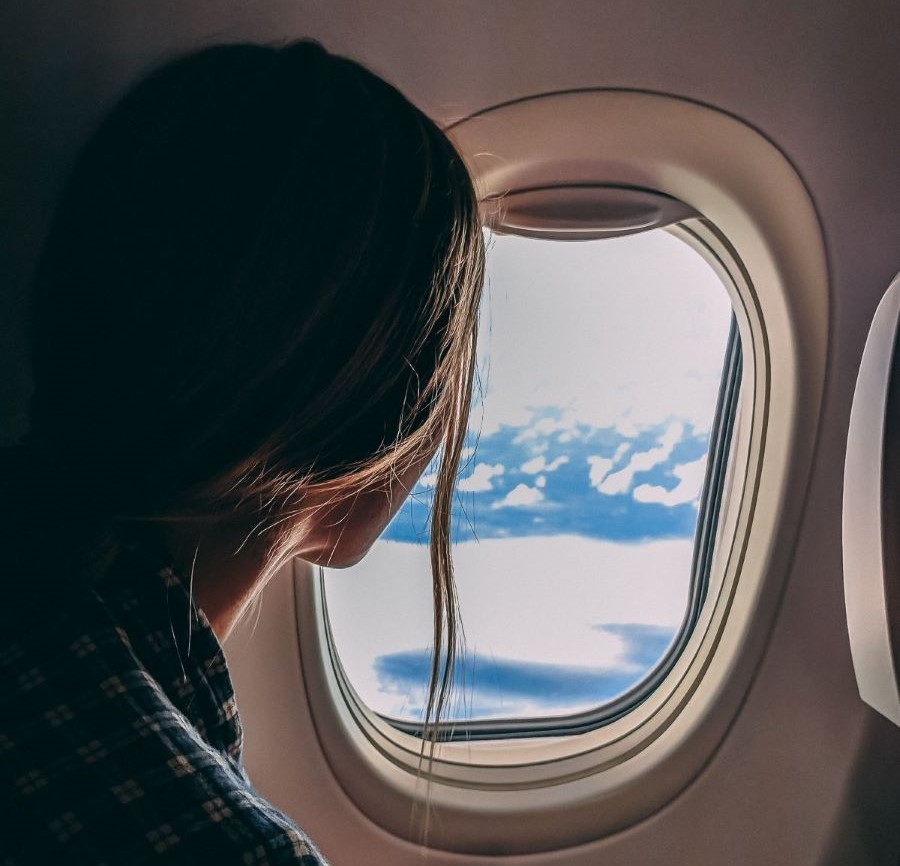Travel sickness, or motion sickness, encompasses symptoms like dizziness, nausea, and vomiting that often occur during travel. These symptoms can manifest at cruising altitude as:
- Pale skin
- Cold sweat
- Dizziness
- Increased saliva production
- Vomiting
Additional symptoms may include:
- Rapid, shallow breathing
- Headaches
- Drowsiness
- Profound fatigue
Fortunately, symptoms tend to improve as your body adapts to the travel conditions.
“Airplane bloat is a common issue that you can prevent,” says Charles Passler, DC, a renowned nutritionist. Identifying the cause of your swelling is the first step.
“Bloat comes in two forms: digestive bloat, which affects the gut due to inflammation or excess gas, and water retention bloat, known as oedema, impacting the entire body due to circulatory issues and fluid buildup.” The techniques to prevent both types of bloat are similar and easily achievable in your flight routine.”
What causes motion sickness even while flying?
Motion sickness crops up when what you’re seeing doesn’t jive with what your inner ear is feeling. This mismatch can bring unpleasant sensations like dizziness, nausea, and sometimes vomiting.
The not-so-fun part is that you can experience this discomfort in various scenarios—whether in a car, on a train, aboard an aeroplane or boat, or even enjoying an amusement park ride.
Now, while motion sickness can damper your travel plans, the good news is that there are strategies to prevent and alleviate it.
How do you stop motion sickness on a plane?
The following measures could be helpful.
- Eat Light: Choose low-sodium, low-fat meals a few hours before flying, and avoid heavy, greasy foods.
- Stay Hydrated: Drink plenty of water to stay hydrated throughout the flight.
- Seat Selection: Opt for a seat closer to the front of the plane to minimize turbulence.
- Ginger to the rescue: Try ginger in various forms, like ginger ale or hard candies, to calm your stomach.
- Limit Reading: Those prone to air sickness should avoid reading during flight. It can add movement to your equilibrium and worsen symptoms.
Following these tips can help ensure a more comfortable and nausea-free flight.
Best healthy snacks for plane travel
It is best to have a light meal before flying, preferably an hour before, to avoid feeling bloated.
Indulging in herbal tea can benefit heart health, cognitive function, and digestive ease.
Additionally, herbal teas can provide soothing relief and aid in managing digestive discomforts, such as nausea, vomiting, indigestion, and constipation.
When hunger strikes, reach for dried fruits, eggs and nuts, and keep hydrated with approximately one litre of water during your flight—low-fibre food to avoid excess bloating.
Opt for these healthy in-flight snacks:
- Nuts and seeds
- Seaweed thins
- Lean Proteins
- Fresh fruit
- Yoghurt
- Vegetable sticks with hummus
- Granola or protein bars
No Fizzy drinks during flight; They can fizzle out your adventure.
Avoid carbonated drinks, alcohol, wine, coffee, and tea, except for herbal teas, during your flight. They can lead to dehydration and disrupt your sleep due to caffeine. Juices, while tasty, often pack extra calories without the hydrating benefits of water.
For a healthier in-flight choice, consider flavoured water with fresh fruit or tomato juice with a touch of pepper – it’s both refreshing and better for your well-being.
Inflammatory Foods to avoid while on a flight
Certain foods can lead to discomfort during your flight:
Beans, Chickpeas, and Lentils: These fibre-rich foods can cause bloating due to sugars called alpha-galactosides, which ferment in the intestines.
Garlic & Onions: Although flavorful, they contain fructans, a type of soluble fibre that may trigger digestive issues. Cooking them or using dried versions can help.
Sugar Alcohols: Found in sugar-free foods and gum, sugar alcohols like xylitol and sorbitol can lead to gas, bloating, and loose stools. Consider alternatives like stevia or monk fruit.
High-Sodium Snacks: Avoid salty snacks to prevent water retention, especially in the dry cabin air.
High-Sugar Snacks: Excess sugar can lead to energy crashes during your flight. Opt for balanced snacks to maintain energy levels.
Stay comfortable and enjoy your journey by choosing your in-flight snacks wisely.
Can I bring water on a plane?
While you can’t carry liquids over 3.4 oz through security (with a few exceptions), you can bring an empty bottle. After passing the security screening, fill up your bottle before boarding your flight. It’s a practical way to stay hydrated during your journey.
Keep moving your body.
Extended periods of sitting during a flight encourage blood pooling and subject your knees to an angle that causes the veins within them to kink. Like water faces obstacles in a twisted garden hose, blood encounters difficulties flowing through these constricted veins.
Moreover, alterations in air pressure within the aeroplane cabin can increase the risk of blood clots.
Therefore, keeping your limbs in motion and incorporating stretches to promote circulation is vital.
Why is my circulation so bad after a long flight?
On long flights, cramped leg space can lead to poor foot circulation. This may cause swollen, painful feet. Prepare for a comfortable flying in the following ways as it may provide relief:
- Wear loose clothing.
- Stay hydrated (limit caffeine).
- Walk around as much as safe
- Do exercises whilst sitting, e.g. lifting knees or making circles with your ankle [ankle rotation]
Wear compression socks when flying?
Compression socks and stockings are specialized garments designed to promote circulation in your calves and feet by applying gentle pressure.
These garments maintain their shape due to their stretchy fabric. For them to work, you need the correct pressure. If you are fit and healthy, you could opt for stockings.
You can buy from the pharmacy, and below the knee is sufficient. If you had a previous clot or risk factors, make sure you get measured appropriately. There are three main types of compression wear:
- Graduated compression socks begin with more significant pressure at the ankles and gradually reduce stress as they ascend the leg. They are usually prescribed and require professional fitting to meet specific medical standards.
- Non-medical support hosiery offers more flexibility than graduated socks and doesn’t require a prescription. They are readily available in stores and online and are often used to relieve tired legs and improve circulation.
- Anti-embolism stockings prevent deep vein thrombosis (DVT) and come in various compression levels. They are typically recommended for individuals with limited mobility and, like graduated compression socks, require a prescription for purchase.
How long do you wear compression socks on a long flight?
When you’re on a long flight and stuck in your seat for hours, wearing compression stockings for the entire flight is generally reasonable.
You may keep them for a few hours after landing. It is usually fine. These stockings help improve your circulation, keeping your legs more comfortable during and after the flight.
Summary
In conclusion, taking care of your well-being while travelling is essential for a comfortable journey. These tips can make a significant difference, from managing motion sickness to choosing the right snacks and staying hydrated.
Remember, your health matters. So, the next time you embark on a trip, be prepared, stay mindful of your choices, and enjoy the journey to the fullest. Safe travels!
To see the video guide based on the above Blog Post, click the link: https://www.youtube.com/watch?v=OBN7YZBd6wc.
References
https://111.wales.nhs.uk/travelhealth/traveltips/#:~:text=Several%20complementary%20therapies%20have%20been,for%20their%20effectiveness%20is%20mixed.&text=Ginger%20supplements%2C%20or%20other%20giner,the%20symptoms%20of%20travel%20sickness
https://www.wellandgood.com/best-ways-prevent-bloating-plane/
https://wwwnc.cdc.gov/travel/page/motion-sickness.
https://www.sheffield.com/how-to-prevent-and-treat-airsickness
https://www.netmeds.com/health-library/post/sip-on-these-aromatic-herbal-teas-for-digestive-health
https://clarissalenherr.com/nutritionist-approved-tips-to-banish-bloating-while-flying/
https://www.cntraveller.in/story/foods-to-eat-and-avoid-before-during-and-after-a-flight-as-per-a-nutritionist/
https://www.tsa.gov/travel/travel-tips/going-green-while-traveling-through-airport-security
https://www.webmd.com/dvt/flying-blood-clots
https://peteodonaldpodiatry.com/blog/item/161-airplane-travel-and-poor-circulation.html.
https://www.healthline.com/health/compression-socks-for-flying#about.
https://www.caringtouchmed.com/need-compression-socks-flying/
Disclaimer: The Content on this channel is for educational purposes and not intended to be a substitute for professional medical advice, diagnosis, or treatment. Always get advice from your doctor if you are worried or have symptoms.


